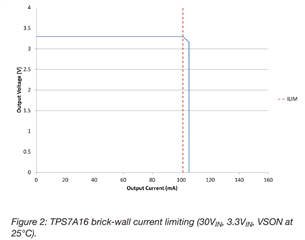Dear team,
For the overcurrent protection, we don't have much description. Could you please help clarify why reduce the output voltage can reduce the current? Do we have any test report for this?

Thanks & Best Regards,
Sherry
This thread has been locked.
If you have a related question, please click the "Ask a related question" button in the top right corner. The newly created question will be automatically linked to this question.
Dear team,
For the overcurrent protection, we don't have much description. Could you please help clarify why reduce the output voltage can reduce the current? Do we have any test report for this?

Thanks & Best Regards,
Sherry
Hi Sherry,
An easy way to think of this is to imagine a purely resistive load. Let's say that VOUT is set at 5V, and there is an 8.33Ω resistive load. This 8.33Ω load will demand 5V / 8.33Ω = 600mA of current at VOUT = 5V, but the LDO will only let 550mA (typical) through it, so the output voltage must fall to support this 550mA load. The voltage that the output falls to is equal to 8.33Ω * 550mA = 4.58V. This is called a brickwall current limiting scheme because the current will not increase further if the current demand increases (hits a brick wall), and the output voltage will continue falling instead. A brickwall current-limited device is basically a current-regulator while operating in this mode. See the image below pulled from the LDO Basics app note.

Regards,
Nick
Hi Nick,
It seems that all overcurrent issue will ends by thermal shutdown, right? If the Vin has a high input and Vout is limited to a small value due to overcurrent, the power consumption is large, so finally our device will be turned off due to thermal protection, right?
Thanks & Best Regards,
Sherry
Hi Sherry,
You are correct in that the power consumption increases when VOUT falls. Whether the device ends up in thermal shutdown mode depends on the board layout (i.e. how thermally optimized the layout is for pulling heat from the device) and the input voltage. If the headroom during normal operation is minimal then there's a chance that the device will not enter thermal shutdown, but chances are it will for many applications.
Regards,
Nick